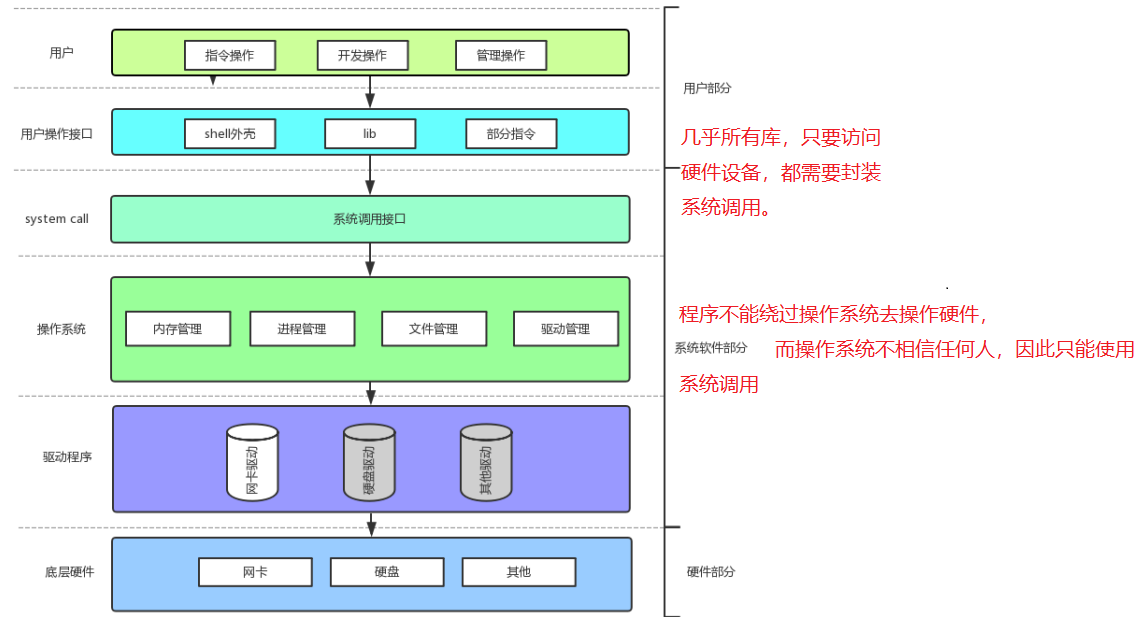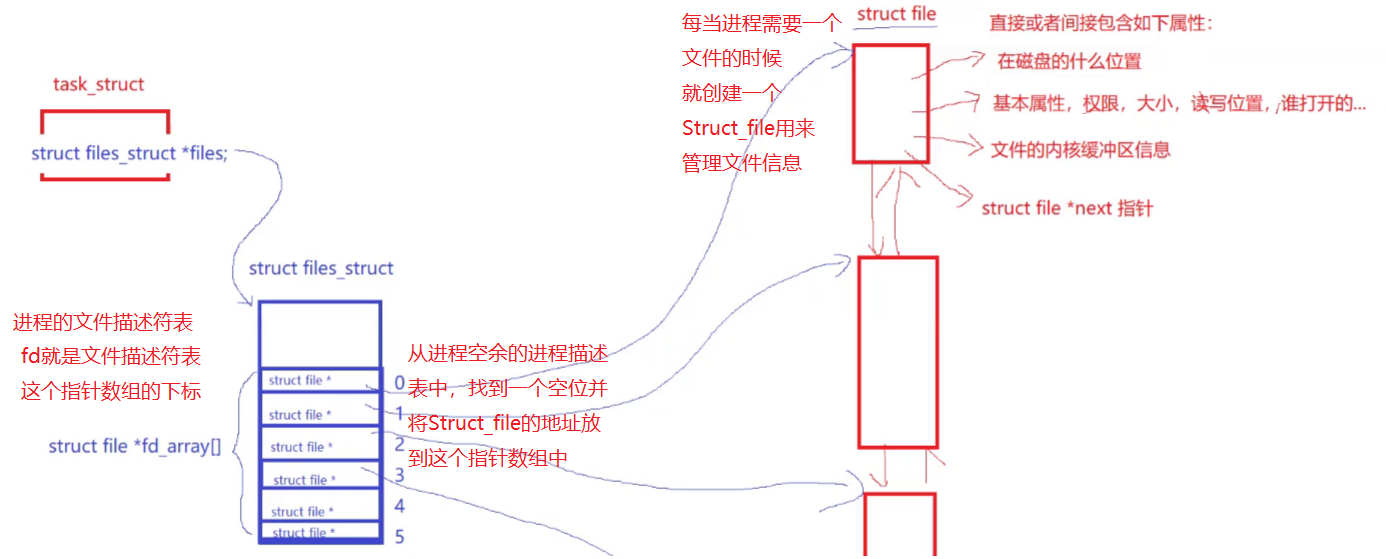文件IO 文件描述符 重定向
文件和进程的关系
概念
- 文件 = 内容 + 属性。
- 文件被打开时,操作系统负责将文件内容加载到内存中,以供CPU调度和访问。
- 访问磁盘(外设)的过程就是访问硬件的过程。
C语言
在C语言中,默认会打开三个输入输出流,分别是stdin,stdout, stderr,这三个流的类型都是FILE*。其中FILE是c语言对进程调用的文件信息进行的一层封装。
FILE *fopen(const char *filename, const char *mode);
fopen()
| Mode | Description |
|---|---|
| r | Open text file for reading. The stream is positioned at the beginning of the file. |
| r+ | Open for reading and writing. The stream is positioned at the beginning of the file. |
| w | Truncate file to zero length or create text file for writing. The stream is positioned at the beginning of the file. |
| w+ | Open for reading and writing. The file is created if it does not exist, otherwise it is truncated. The stream is positioned at the beginning of the file. |
| a | Open for appending (writing at end of file). The file is created if it does not exist. The stream is positioned at the end of the file. |
| a+ | Open for reading and appending (writing at end of file). The file is created if it does not exist. The initial file position for reading is at the beginning of the file, but output is always appended to the end of the file. |
系统调用

上述库函数也使用了系统调用。例如c语言中的fopen()就封装了open()。
我们还可以直接采用系统接口来进行文件访问文件。
例如:open()
1 | |
- pathname: 打开文件的名字。
- flags: 访问模式
- mode(可选):创建新文件时使用的权限(如目标文件不存在,需要open创建,则第三个参数表示创建文件的默认权限,否则,使用两个参数的open。)。
- mode参数权限(例如0666)
| Position | Octal | Binary | Meaning |
|---|---|---|---|
| Special | 0 | 000 | No special permissions |
| User | 6 | 110 | Read + Write |
| Group | 6 | 110 | Read + Write |
| Others | 6 | 110 | Read + Write |
- 返回值
1 | |
| 标志位名称 | 作用 |
|---|---|
| O_RDONLY | 只读打开 |
| O_WRONLY | 只写打开 |
| O_RDWR | 读,写,打开这三个常量,必须指定一个且只能指定一个 |
| O_CREAT | 若文件不存在,则创建它。需要使用mode选项,来指明新文件的访问权限 |
| O_APPEND | 追加写 |
fd和FILE *
fd:文件描述符
那这两者的返回值有什么关系呢?
在进程想要访问磁盘文件的时候,内核会生成一个struct file结构体,内部会包含文件各种各样的信息(内部也包含了一个 struct inode和address space,用来存储inode和page的相关的信息)。并用了双链表的形式将不同struct file结构体联系起来。
一个进程和它打开的文件使用pcb——task_struct和struct_files(文件描述符表)联系起来

fd是文件描述符表的下标,当fd == -1的时候,此时打开失败。一个进程的
fd分配规则:从0下标开始,寻找最小的没有使用的数组位置,它的下标就是新文件的文件描述符。
操作系统会默认打开以下文件便于用户使用。这时操作系统的特性,而不是语言的特性(Linux下一切皆文件)
stdin:键盘文件
fd == 0stdout:显示器文件
fd == 1stdeer:显示器文件
fd == 2
(可以使用类似stdin->_fileno来验证)
close() 和 引用计数
一个struct_file可能被多个进程使用,其中每多一个进程,struct_file中的引用计数就自增,反之自减。
当执行关闭进程的时候,我们只需要
- 根据提供的文件描述符,定位到文件描述符表的某个位置。
- 通过文件描述符表找到
struct_file,并将引用计数自减。 - 在进程的文件描述符表中将文件描述符的位置置空。
重定向
- 原理:将进程的进程描述表中需要重定向的位置上的地址内容替换为重定向目标文件的地址。
使用系统调用接口 int dup2(int oldfd, int newfd);
(复制oldfd对应的地址,粘贴替换到newfd对应的地址上)
重定向的符号
| Symbol | Meaning |
|---|---|
> |
Output redirection |
>> |
Append output redirection |
< |
Input redirection |
| & | This indicates that what follows is a file descriptor, not a file name. |
<< |
Here document (input redirection) |
<<< |
Here string (input redirection) |
- eg(指令从左往右执行):
command > output.txt 2>&1
其运行时:- 将
1(stdout)的内容重定向输出到output.txt中。 - 将stdeer重定向到
1,即也重定向output.txt中。
- 将